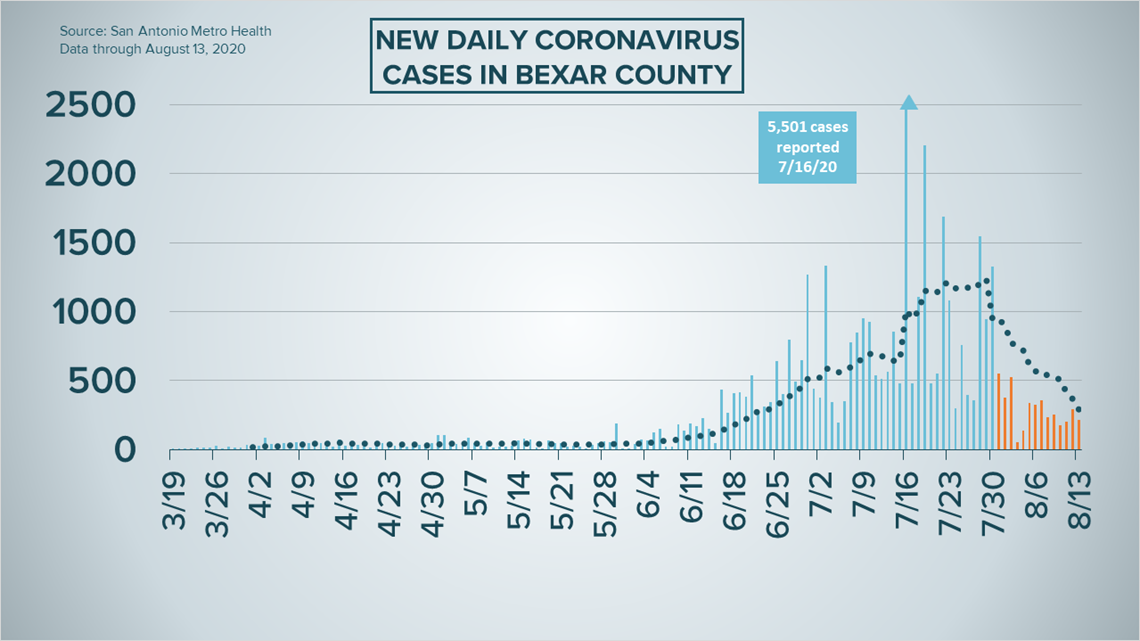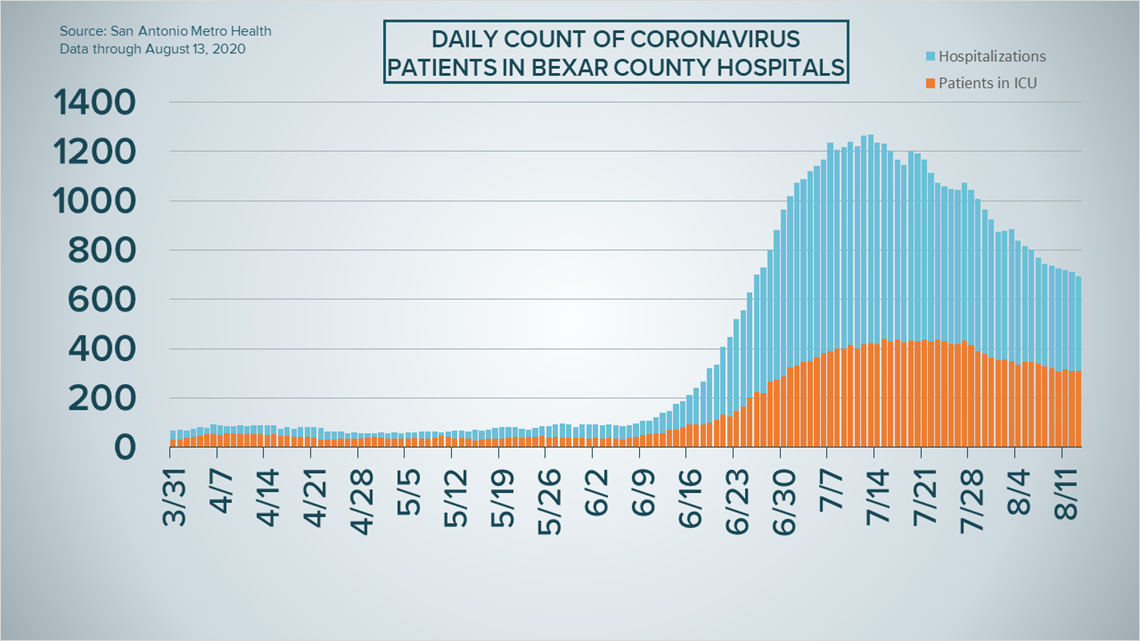SAN ANTONIO — We're tracking the latest numbers from the coronavirus pandemic in San Antonio and across Texas. Here are the latest numbers reported by Bexar and surrounding counties:
- Bexar County: 218 new cases were reported Thursday, bringing the total number for the county to 43,673. The county death toll, meanwhile, rose to 560 after 15 additional fatalities were reported; those deaths stretch back to June 19.
- Comal County: The county reported 17 new cases and one new death Thursday. There have been a total of 2,573 cases of COVID-19 in the county – including 2,008 confirmed cases – while 72county residents have died. County officials say there are 471 active coronavirus cases, and 2,030 residents have recovered.
- Hays County: Officials in Hays County on Thursday reported 20 new cases in the county and one additional virus-related death. As of Thursday evening, there were a total of 5,103 lab-confirmed cases in the county (2,673 of which are active) while the death toll increased 38.
How Bexar County is trending
We're tracking how many coronavirus cases are confirmed in Bexar County each day from the time San Antonio Metro Health began reporting cases more than five months ago. Graphing those daily case numbers along a 14-day moving average provides an accurate picture of the curve in the San Antonio area and the direction we're heading amid the coronavirus.
On Thursday, Mayor Ron Nirenberg reported an additional 218 cases of the novel coronavirus in Bexar County, bringing the total to 43,673. The seven-day average for the county for daily cases has decreased from 259 to 253.
The local death toll, meanwhile, rose to 560 after Nirenberg confirmed an additional 15 deaths from COVID-19 complications. Those deaths date back to as early as June 19; more than 200 local deaths are still being investigated for potential coronavirus connections.


For the first time since June 26, hospitalizations have dropped below 700 in Bexar County; on Thursday, 694 residents were receiving treatment for virus symptoms. The number of residents on ventilators (213) and in intensive care (311) was also down slightly from Wednesday.


Coronavirus in Texas
Texas health authorities on Thursday reported an additional 6,755 cases of the coronavirus from across the state, bringing the total to 513,575. The death toll, meanwhile, rose to 9,289 after 255 more deaths from COVID-19 complications were reported.


The rate of hospitalized Texans continues to go down. On Thursday, 6,879 residents were receiving treatment for COVID-19 symptoms, more than 200 fewer than on Wednesday. The last time the number of hospitalized Texans was below 7,000 was July 1.
The state's positivity rate took a steep drop Thursday; it's now at 16%, down from 25% reported Wednesday.
Lastly, an estimated 375,760 Texans have recovered from the virus during the ongoing pandemic.
Latest Coronavirus Headlines
- 'COVID-19 really can’t stop love' | Critically ill San Antonio man weds fiancé at hospital
- Biden calls for nationwide mask mandate
- Texas testing numbers have dropped dramatically. Here is why.
- Lawmakers leave Capitol Hill without new virus aid in sight, as Americans wait
- Poteet ISD suspends all extracurricular activities after coronavirus policies were breached
Coronavirus symptoms
The symptoms of coronavirus can be similar to the flu or a bad cold. Symptoms include fever or chills, cough, shortness of breath or difficulty breathing, fatigue, muscle or body aches, headache, new loss of taste or smell sore throat, congestion or runny nose, nausea or vomiting and diarrhea, according to the Centers for Disease Control.
Most healthy people will have mild symptoms. A study of more than 72,000 patients by the Centers for Disease Control in China showed 80 percent of the cases there were mild.
But infections can cause pneumonia, severe acute respiratory syndrome, kidney failure, and even death, according to the World Health Organization. Older people with underlying health conditions are most at risk.
On June 25, the CDC expanded the list of groups at a higher risk of severe illness due to coronavirus.
Experts determined there was consistent evidence these conditions increase a person's risk, regardless of age:
- Chronic kidney disease
- COPD (chronic obstructive pulmonary disease)
- Obesity (BMI of 30 or higher)
- Immunocompromised state (weakened immune system) from solid organ transplant
- Serious heart conditions, such as heart failure, coronary artery disease, or cardiomyopathies
- Sickle cell disease
- Type 2 diabetes
The CDC believes symptoms may appear anywhere from two to 14 days after being exposed.
Human coronaviruses are usually spread...
- Between people who are in close contact with one another (within about 6 feet).
- Through respiratory droplets produced when an infected person coughs, sneezes or talks. These droplets can land in the mouths or noses of people who are nearby or possibly be inhaled into the lungs.
- Some recent studies have suggested that COVID-19 may be spread by people who are not showing symptoms.
Help stop the spread of coronavirus
- Stay home when you are sick.
- Eat and sleep separately from your family members
- Use different utensils and dishes
- Cover your cough or sneeze with your arm, not your hand.
- If you use a tissue, throw it in the trash.

